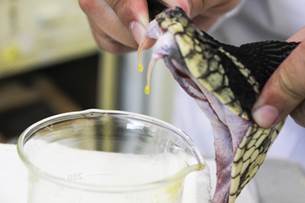合成生物学解决全球抗蛇毒血清短缺
来源:PLOS Neglected Tropical Diseases
作者:Paulo Lee Ho等
时间:2016-04-25


本报讯 当医疗慈善机构无国界医生在去年9月称全球正面临抗蛇毒血清短缺的公共卫生危机时,巴西生物化学家Paulo Lee Ho并未感到惊讶。他的整个职业生涯都是在圣保罗的布坦坦研究所寻找制造抗蛇毒血清的更佳途径,从而治疗银环蛇的咬伤。
传统方法依赖于天然银环蛇毒液,但这是很难获得的:蛇的每一咬只产生少量的毒液,并且在人工饲养环境中很难提高。因此Ho和其他科学家转而求助于蛋白质组学以及合成生物学,旨在改善抗蛇毒血清的质量与可用性。他说:“我们需要一种新的方法满足来自卫生部的抗蛇毒血清需求。”
如今,这些努力正在开花结果。今年3月,Ho与同事报告说,他们设计了一种脱氧核糖核酸(DNA)短链,在将其添加到小鼠体内后触发了抗银环蛇毒液的抗体。研究人员随后通过一同注射在大肠杆菌中的合成毒液抗体增强了啮齿动物的免疫响应。
在3月发表的另一项独立研究中,巴西的另一研究团队利用人工合成抗体片段中和了蝮蛇的咬伤。
英国利物浦热带医学院阿里斯泰尔·里德毒液研究部门负责人Robert Harrison表示,考虑到发展中国家因毒蛇咬伤造成的沉重医疗负担,这样的进展令人欢欣鼓舞。每年大约有9万人因毒蛇咬伤而死亡。
然而一个多世纪以来,抗蛇毒血清的制造方法一直没有改变。大型动物——通常是马——被注射进少量提取自蛇毒的纯化蛋白质,从而促使抗体的产生。包含这些抗体的血浆随后被施用于蛇毒受害者。
但是这种救命的方法存在巨大的局限性。每一种抗蛇毒血清只能有效对付一种,或是一小类蛇毒。并且这些药物必须要冷藏使用,而热带国家面临的一个困难便是缺乏可靠的电力供应。
美国图森市亚利桑那大学毒液、免疫化学、药理学和急救反应研究所所长Leslie Boyer表示:“当你想到它,这些抗蛇毒血清的作用真是太神奇了。”
生产抗蛇毒血清的制药公司的数量目前正在下降,因为这种药物并不是很赚钱。例如在2010年,制药巨头、法国巴黎的赛诺菲公司便停止生产抗蛇毒血清Fav-Afrique,后者旨在治疗非洲毒性最强的10种毒蛇的咬伤。
Ho希望他的方法能够有助于填补这一空白。与依赖从活体银环蛇中提取毒液不同,他从编码蛇毒毒素的银环蛇DNA片段入手。他和同事将这些DNA片段注入小鼠体内以启动它们的免疫系统。1个月后,研究人员再向这些啮齿动物体内注射包含合成蛇毒抗体的后续疫苗。
在接受了Ho的试验治疗后,只有60%的小鼠在注射了致命剂量的银环蛇毒液后幸存下来,相比之下,现有抗蛇毒血清的存活率为100%。但Ho并未气馁。他说:“这一结果表明还有其他途径获得中和抗体。或许为了获得更好的治疗效果,我们需要使用更多的抗体再试一次。我们只是还不知道它是什么。”
由波多维利乌港Fundacao Oswaldo Cruz(基金会)生物医学研究所分子生物学家Carla Fernandes领衔的另一个巴西研究团队测试了另一种不同的方法。他们使用噬菌体展示库,制造了向美洲驼注射蝰蛇毒液产生的抗体的人工合成版本。向蛇咬伤受害者施用这种抗体能够避免对动物血浆的需求。相比传统的抗蛇毒血清,它还可以减少咬伤部位的肌肉损伤和组织死亡,因为合成抗体更小,从而能够更好地渗透到组织内部。
新的抗蛇毒血清的研制道路并非畅通无阻,但研究人员认为关键在于进展迅速。Harrison表示:“这一领域有着显著而快速的进步,但它需要更快的发展。有太多的人死于从根本上讲是可以预防的一种疾病。”
然而对Boyer来说,抗蛇毒血清短缺并不是因为缺少科学研究导致的。她说:“只需14美元制造的一小瓶抗蛇毒血清在美国却需要花1.4万美元。”Boyer指出:“你不会买到比这更便宜的。昂贵的部分并不是科学,而是每个人都想要的利润促使价格变得那么遥不可及。”
蛇毒是毒蛇从毒腺中分泌出来的一种液体,分为神经性毒液和溶血性毒液,主要成分是毒性蛋白质,约占干重的90%至95%。酶类和毒素约含二十多种。此外,还含有一些小分子肽、氨基酸、碳水化合物、脂类、核苷、生物胺类及金属离子等。蛇毒成分十分复杂,不同蛇毒的毒性、药理及毒理作用各具特点。(来源:中国科学报 赵熙熙)
A Heterologous Multiepitope DNA Prime/Recombinant Protein Boost Immunisation Strategy for the Development of an Antiserum against Micrurus corallinus (Coral Snake) Venom
Abstract Background Envenoming by coral snakes (Elapidae: Micrurus), although not abundant, represent a serious health threat in the Americas, especially because antivenoms are scarce. The development of adequate amounts of antielapidic serum for the treatment of accidents caused by snakes like Micrurus corallinus is a challenging task due to characteristics such as low venom yield, fossorial habit, relatively small sizes and ophiophagous diet. These features make it difficult to capture and keep these snakes in captivity for venom collection. Furthermore, there are reports of antivenom scarcity in USA, leading to an increase in morbidity and mortality, with patients needing to be intubated and ventilated while the toxin wears off. The development of an alternative method for the production of an antielapidic serum, with no need for snake collection and maintenance in captivity, would be a plausible solution for the antielapidic serum shortage. Methods and Findings In this work we describe the mapping, by the SPOT-synthesis technique, of potential B-cell epitopes from five putative toxins from M. corallinus, which were used to design two multiepitope DNA strings for the genetic immunisation of female BALB/c mice. Results demonstrate that sera obtained from animals that were genetically immunised with these multiepitope constructs, followed by booster doses of recombinant proteins lead to a 60% survival in a lethal dose neutralisation assay. Conclusion Here we describe that the genetic immunisation with a synthetic multiepitope gene followed by booster doses with recombinant protein is a promising approach to develop an alternative antielapidic serum against M. corallinus venom without the need of collection and the very challenging maintenance of these snakes in captivity.
原文链接:http://journals.plos.org/plosntds/article?id=10.1371/journal.pntd.0004484
Inhibition of the Myotoxicity Induced by Bothrops jararacussu Venom and Isolated Phospholipases A2 by Specific Camelid Single-Domain Antibody Fragments
Abstract Antivenoms, produced using animal hyperimmune plasma, remains the standard therapy for snakebites. Although effective against systemic damages, conventional antivenoms have limited efficacy against local tissue damage. Additionally, the hypersensitivity reactions, often elicited by antivenoms, the high costs for animal maintenance, the difficulty of producing homogeneous lots, and the instability of biological products instigate the search for innovative products for antivenom therapy. In this study, camelid antibody fragments (VHH) with specificity to Bothropstoxin I and II (BthTX-I and BthTX-II), two myotoxic phospholipases from Bothrops jararacussu venom, were selected from an immune VHH phage display library. After biopanning, 28 and 6 clones recognized BthTX-I and BthTX-II by ELISA, respectively. Complementarity determining regions (CDRs) and immunoglobulin frameworks (FRs) of 13 VHH-deduced amino acid sequences were identified, as well as the camelid hallmark amino acid substitutions in FR2. Three VHH clones (KF498607, KF498608, and KC329718) were capable of recognizing BthTX-I by Western blot and showed affinity constants in the nanomolar range against both toxins. VHHs inhibited the BthTX-II phospholipase A2 activity, and when tested for cross-reactivity, presented specificity to the Bothrops genus in ELISA. Furthermore, two clones (KC329718 and KF498607) neutralized the myotoxic effects induced by B. jararacussu venom, BthTX-I, BthTX-II, and by a myotoxin from Bothrops brazili venom (MTX-I) in mice. Molecular docking revealed that VHH CDRs are expected to bind the C-terminal of both toxins, essential for myotoxic activity, and to epitopes in the BthTX-II enzymatic cleft. Identified VHHs could be a biotechnological tool to improve the treatment for snake envenomation, an important and neglected world public health problem.
原文链接:http://journals.plos.org/plosone/article?id=10.1371/journal.pone.0151363




